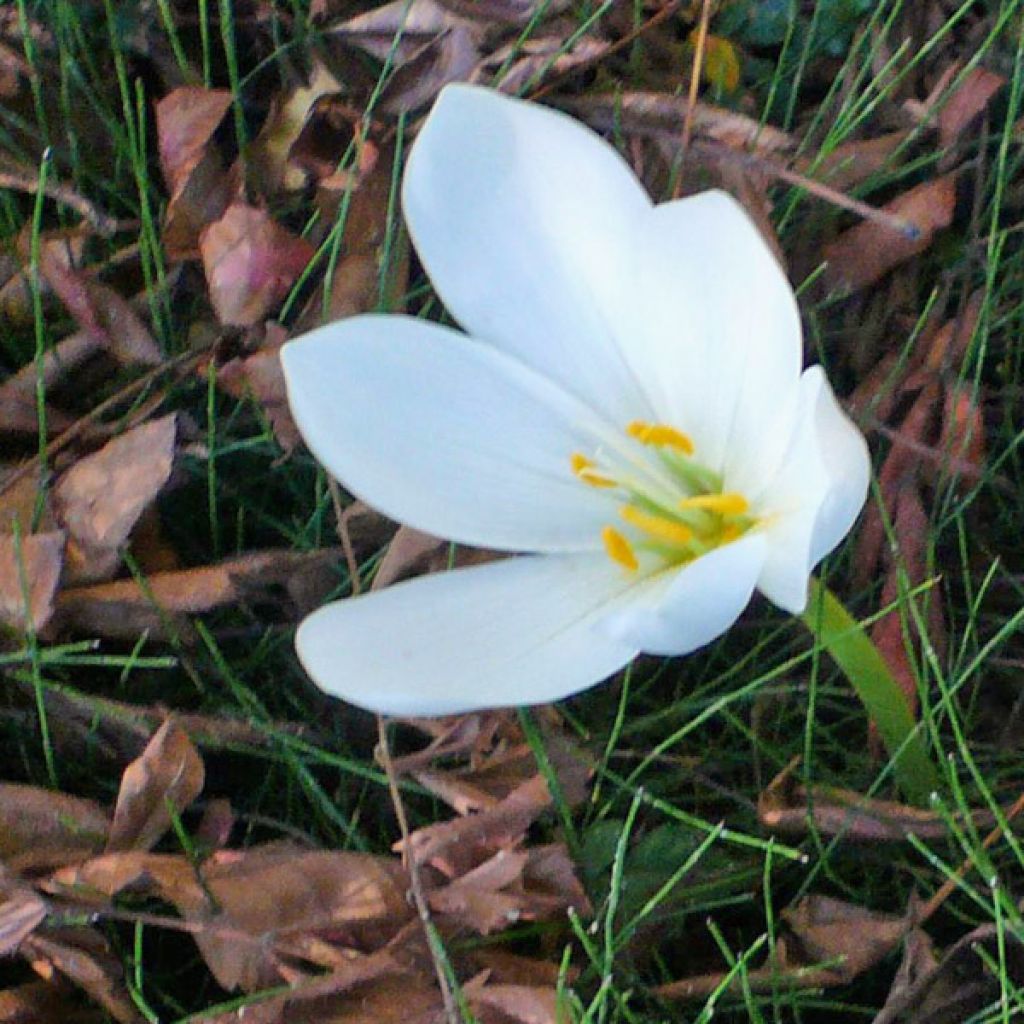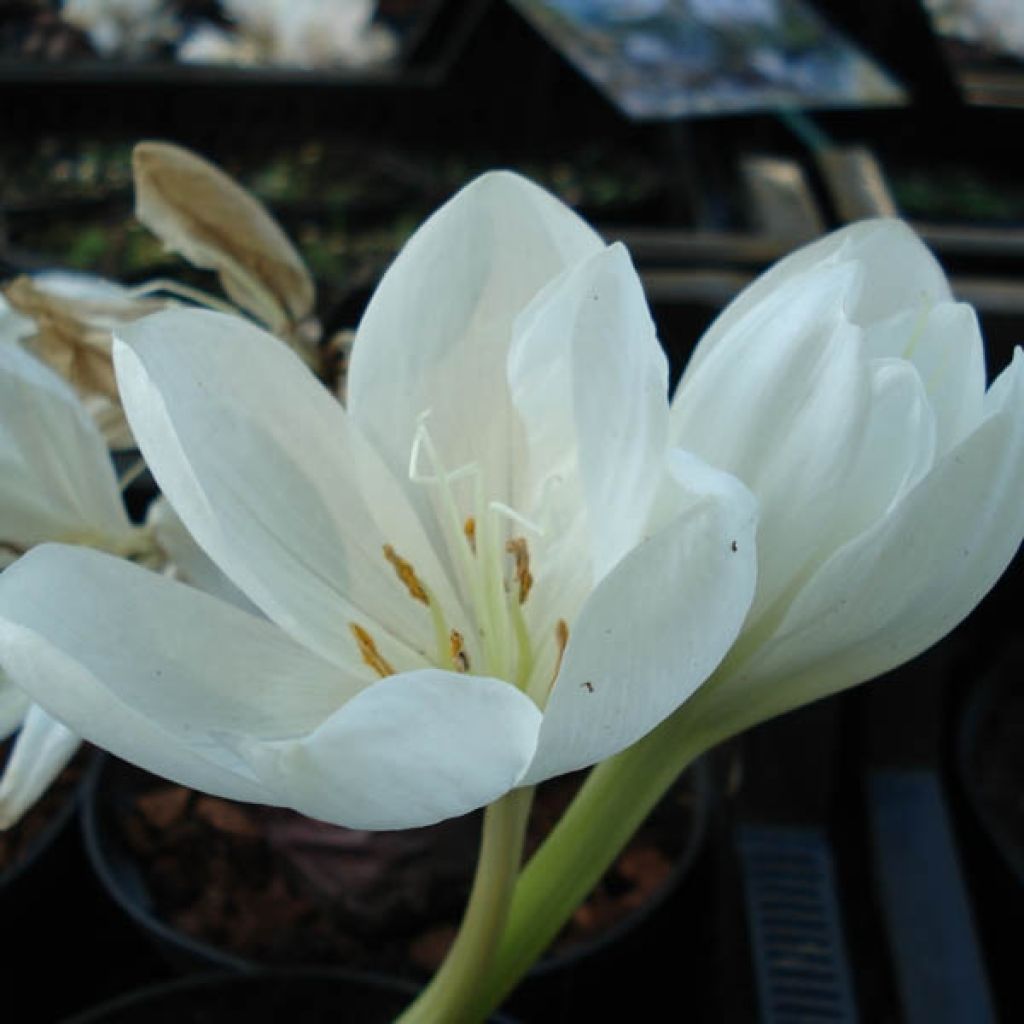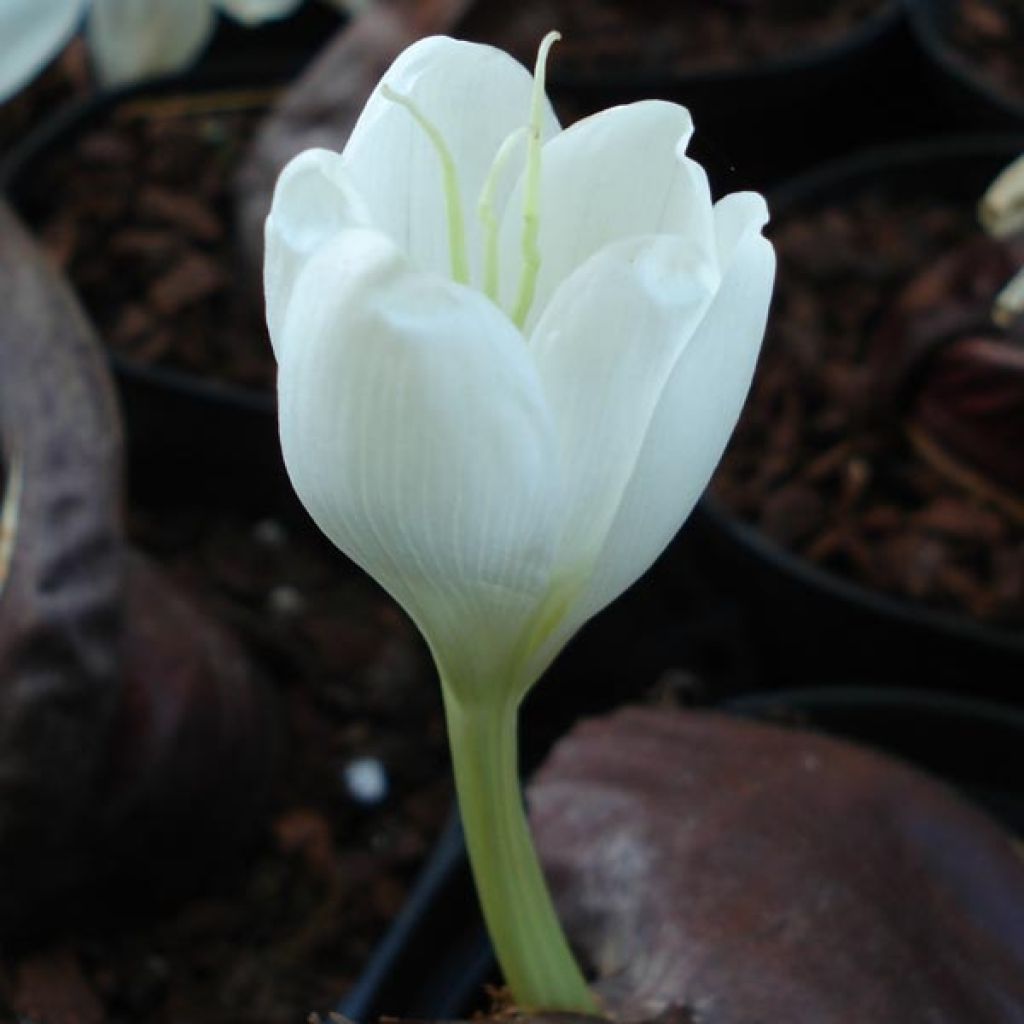

Colchicum speciosum Album - Autumn crocus


Colchicum speciosum Album - Autumn crocus


Colchicum speciosum Album - Autumn crocus
Colchicum speciosum Album - Autumn crocus
Colchicum speciosum Album
Autumn Crocus, Meadow Saffron
Exquisite flowers of a very pure whiteness.
Franck M., 10/03/2018
This plant carries a 6 months recovery warranty
More information
We guarantee the quality of our plants for a full growing cycle, and will replace at our expense any plant that fails to recover under normal climatic and planting conditions.
From €5.90 for pickup delivery and €6.90 for home delivery
Express home delivery from €8.90.


Does this plant fit my garden?
Set up your Plantfit profile →
Description
Colchicum speciosum Album, related to the famous pink colchicum (Colchicum autumnale), is a beautiful pure white flower form of the Caucasian colchicum, a mountain species appreciated for its vigour, robustness, and floribundity. Its large luminous flowers appear in October, emerging in large numbers at ground level like alabaster tulips, unaffected by bad weather. Plant it in rockeries, on the edge of woodland, or in a lightly trodden area of the lawn.
Colchicum speciosum, from the lily family, is a bulbous plant native to the Caucasus, northeastern Turkey, and Iran, where it is found at altitudes of up to 3000m in subalpine meadows. It is a spring-growing plant that remains dormant underground during the summer and blooms in early autumn. The 'Album' form is distinguished by the perfect white of its flowers.
The foliage emerges from the ground in spring, in April-May. It consists of long lanceolate, bright green, shiny leaves measuring up to 25cm long and 8-10cm wide, gathered in a small tuft similar to ornamental garlic. Flowering begins at the end of September. Each bulb or corm produces one to three large flowers with 6 petals fused at the base into a long tube starting from the root. They open into a graceful flared, pure white cup, 7-8cm in diameter. These flowers are carried by a robust emerald-coloured tube, which allows them to withstand rain. An older plant can produce up to 50 flowers. The 'bulb' of the colchicum is actually a corm, an underground storage organ that allows the plant to survive the harsh season. It multiplies by producing numerous baby corms, allowing the colchicum to form large clumps over the years. This plant also multiplies by producing fruits, which are easy to see in spring, nestled among the foliage.
Colchicum speciosum 'Album' announces the arrival of autumn but also often celebrates the advent of a beautiful late season, one of the most beautiful moments of the year in the garden. While it adapts to most regions, colchicum dislikes severe heat waves and excessively dry soils in summer. It can be used in rockeries, in lightly wooded areas, but also in meadows alongside Naples cyclamens, black mondo grass, crocuses, and grape hyacinths, in seasonal pots, as well as in autumn bouquets with long spikes of amaranth, for example. It thrives best in alpine climates, with summer rainfall and distinct winters. All parts of the colchicum are toxic, and the plant is not greatly bothered by most predators in our gardens.
Report an error about the product description
Plant habit
Flowering
Foliage
Safety measures
Botanical data
Colchicum
speciosum
Album
Liliaceae
Autumn Crocus, Meadow Saffron
Cultivar or hybrid
ingestion
Cette plante est toxique si elle est ingérée volontairement ou involontairement.
Ne la plantez pas là où de jeunes enfants peuvent évoluer, et lavez-vous les mains après l'avoir manipulée.
Pensez à conserver l'étiquette de la plante, à la photographier ou à noter son nom, afin de faciliter le travail des professionnels de santé.
Davantage d'informations sur https://plantes-risque.info
Planting and care
Plant Colchicum Speciosum Album in full sun in a deep (15 cm deep), fertile and well-drained but not too dry soil. Space them 10 to 15 cm apart and they will settle in very quickly. Plant the colchicums in July-August so they can flower in the first year of planting. After planting, leave them in place as they don't like to be disturbed. The colchicums will flower in October. After flowering, they go dormant until spring and their leaves will bloom in May and completely disappear in June. All parts of the colchicum are toxic.
Planting period
Intended location
Care
-
, onOrder confirmed
Reply from on Promesse de fleurs
Haven't found what you were looking for?
Hardiness is the lowest winter temperature a plant can endure without suffering serious damage or even dying. However, hardiness is affected by location (a sheltered area, such as a patio), protection (winter cover) and soil type (hardiness is improved by well-drained soil).

Photo Sharing Terms & Conditions
In order to encourage gardeners to interact and share their experiences, Promesse de fleurs offers various media enabling content to be uploaded onto its Site - in particular via the ‘Photo sharing’ module.
The User agrees to refrain from:
- Posting any content that is illegal, prejudicial, insulting, racist, inciteful to hatred, revisionist, contrary to public decency, that infringes on privacy or on the privacy rights of third parties, in particular the publicity rights of persons and goods, intellectual property rights, or the right to privacy.
- Submitting content on behalf of a third party;
- Impersonate the identity of a third party and/or publish any personal information about a third party;
In general, the User undertakes to refrain from any unethical behaviour.
All Content (in particular text, comments, files, images, photos, videos, creative works, etc.), which may be subject to property or intellectual property rights, image or other private rights, shall remain the property of the User, subject to the limited rights granted by the terms of the licence granted by Promesse de fleurs as stated below. Users are at liberty to publish or not to publish such Content on the Site, notably via the ‘Photo Sharing’ facility, and accept that this Content shall be made public and freely accessible, notably on the Internet.
Users further acknowledge, undertake to have ,and guarantee that they hold all necessary rights and permissions to publish such material on the Site, in particular with regard to the legislation in force pertaining to any privacy, property, intellectual property, image, or contractual rights, or rights of any other nature. By publishing such Content on the Site, Users acknowledge accepting full liability as publishers of the Content within the meaning of the law, and grant Promesse de fleurs, free of charge, an inclusive, worldwide licence for the said Content for the entire duration of its publication, including all reproduction, representation, up/downloading, displaying, performing, transmission, and storage rights.
Users also grant permission for their name to be linked to the Content and accept that this link may not always be made available.
By engaging in posting material, Users consent to their Content becoming automatically accessible on the Internet, in particular on other sites and/or blogs and/or web pages of the Promesse de fleurs site, including in particular social pages and the Promesse de fleurs catalogue.
Users may secure the removal of entrusted content free of charge by issuing a simple request via our contact form.
The flowering period indicated on our website applies to countries and regions located in USDA zone 8 (France, the United Kingdom, Ireland, the Netherlands, etc.)
It will vary according to where you live:
- In zones 9 to 10 (Italy, Spain, Greece, etc.), flowering will occur about 2 to 4 weeks earlier.
- In zones 6 to 7 (Germany, Poland, Slovenia, and lower mountainous regions), flowering will be delayed by 2 to 3 weeks.
- In zone 5 (Central Europe, Scandinavia), blooming will be delayed by 3 to 5 weeks.
In temperate climates, pruning of spring-flowering shrubs (forsythia, spireas, etc.) should be done just after flowering.
Pruning of summer-flowering shrubs (Indian Lilac, Perovskia, etc.) can be done in winter or spring.
In cold regions as well as with frost-sensitive plants, avoid pruning too early when severe frosts may still occur.
The planting period indicated on our website applies to countries and regions located in USDA zone 8 (France, United Kingdom, Ireland, Netherlands).
It will vary according to where you live:
- In Mediterranean zones (Marseille, Madrid, Milan, etc.), autumn and winter are the best planting periods.
- In continental zones (Strasbourg, Munich, Vienna, etc.), delay planting by 2 to 3 weeks in spring and bring it forward by 2 to 4 weeks in autumn.
- In mountainous regions (the Alps, Pyrenees, Carpathians, etc.), it is best to plant in late spring (May-June) or late summer (August-September).
The harvesting period indicated on our website applies to countries and regions in USDA zone 8 (France, England, Ireland, the Netherlands).
In colder areas (Scandinavia, Poland, Austria...) fruit and vegetable harvests are likely to be delayed by 3-4 weeks.
In warmer areas (Italy, Spain, Greece, etc.), harvesting will probably take place earlier, depending on weather conditions.
The sowing periods indicated on our website apply to countries and regions within USDA Zone 8 (France, UK, Ireland, Netherlands).
In colder areas (Scandinavia, Poland, Austria...), delay any outdoor sowing by 3-4 weeks, or sow under glass.
In warmer climes (Italy, Spain, Greece, etc.), bring outdoor sowing forward by a few weeks.



































